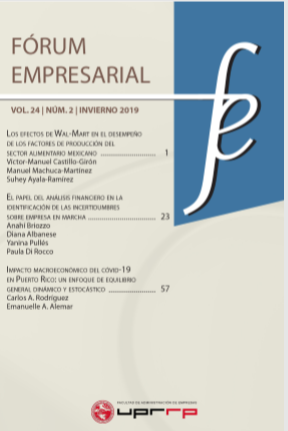Abstract
This paper studies the potential dynamic impact of COVID-19 in Puerto Rico from the perspective of the indirect cost of the disease. For these purposes, a health shock is introduced into a calibrated DSGE model as proposed by Torój (2013). The macroeconomic effects of this shock are simulated when the disease spreads expectedly and unexpectedly. Simulation results indicate that the spread of the disease can result in aggregate output contractions ranging from 1.8% to 5.4%. If the virus is not contained in that same period, this contraction can have a persistence of up to eight quarters and result in permanent contractions of up to 2% under no lockdown measures and conservative disease spread scenarios. This implies a significant indirect cost related to the spread of the disease if social distancing measures were not put in place or were to be lifted. At the same time, the importance of continuing to mitigate the negative economic impact of lockdown measures through expansive fiscal policy is highlighted.References
Arrow, K. J. (1971). Aspects of the theory of risk-bearing, Yrjö Jahnssonin Säätiö lectures. (1965). En K. J. Arrow (Ed.), reimpreso en Essays in the theory of risk bearing (pp. 90‒120). Markham.
Baldwin, R., & Weder di Mauro, B. (2020). Economics in the time of COVID-19. Centre for Economic Policy Research. www.cepr.org
Blanchard, O. J., & Kahn, C. M. (1980). The solution of linear difference models under rational expectations. Econometrica: Journal of the Econometric Society, 48(5), 1305‒1311.
Calvo, G. A. (1983). Staggered prices in a utility-maximizing framework. Journal of Monetary Economics, 12(3), 383‒398.
Cochrane, J. H. (2020). Corona virus monetary policy. Economics in the time of COVID-19. Centre for Economic Policy Research. www.cepr.org
Cooley, T. F., & Hansen, G. D. (1989). The inflation tax in a real business cycle model. The American Economic Review, 79(4) 733‒748.
Department of Health Systems Financing Health Systems and Services. (2009). Who guide to identifying the economic consequences of disease and injury. World Health Organization. https://apps.who.int/iris/bitstream/handle/10665/137037/9789241598293_eng.pdf
Erceg, C. J., Henderson, D. W., & Levin, A. T. (2000). Optimal monetary policy with staggered wage and price contracts. Journal of Monetary Economics, 46(2), 281–313.
Fernández-Villaverde, J. (2010). The econometrics of DSGE models. SERIEs, 1(1-2), 3‒49.
Hansen, G. D. (1985). Indivisible labor and the business cycle. Journal of Monetary Economics, 16(3), 309‒327.
H.R.748-116th Congress (2019-2020): CARES Act. (2020, March 27). https://www.congress.gov/bill/116th-congress/house-bill/748
Junta de Planificación. (2019). Apéndice estadístico del informe económico a la Gobernadora. Gobierno de Puerto Rico. http://jp.pr.gov/Economía/Apêndice
Koopmanschap, M. A., Rutten, F. F. H., van Ineveld, B. M., & van Roijen, L. (1995). The friction cost method for measuring indirect costs of disease. Journal of Health Economics, 14(2), 171–189. https://doi.org/10.1016/0167-6296(94)00044-5
Kydland, F. E., & Prescott, E. C. (1982). Time to build and aggregate fluctuations. Econometrica: Journal of the Econometric Society, 50(6) 1345‒1370.
McCandless, G. (2008). The ABC's of RBC's. Harvard UP.
Pauly, M. V., Nicholson, S., Xu, J., Polsky, D., Danzon, P. M., Murray, J. F., & Berger, M. L. (2002). A general model of the impact of absenteeism on employers and employees. Health Economics, 11(3), 221–231.
Pratt, J. W. (1964). Risk aversion in the large and in the small. Econometrica, 32(1-2), 122-136.
Puerto Rico Oversight, Management, and Economic Stability Act (PROMESA), Pub. L. No. 114-187, 130 Stat. 549 (2016). https://www.govinfo.gov/content/pkg/PLAW-114publ187/html/PLAW-114publ187.htm
Sims, E. (2017). Graduate macro theory II: a new Keynesian model with price stickiness [notas]. University of Notre Dame. https://www3.nd.edu/~esims1/new_keynesian_2017.pdf
Sosa Pascual, O. (25 marzo 2020). Miles morirían en Puerto Rico por el COVID-19. Centro de Periodismo Investigativo. http://periodismoinvestigativo.com/2020/03/miles-moririan-en-puerto-rico-por-el-covid-19/
Taylor, J. B. (1980). Aggregate dynamics and staggered contracts. Journal of Political Economy, 88(1), 1‒23.
Torój, A. (2013). Why don‘t Blanchard-Kahn ever "catch" flu? And how it matters for measuring indirect cost of epidemics in DSGE framework. Central European Journal of Economic Modelling and Econometrics, 5(3), 185–206.
World Health Organization. (2019). Coronavirus disease (COVID-2019) situation reports. https://www.who.int/emergencies/diseases/novel-coronavirus-2019/situation-reports
Wrona, W., Hermanowski, T., Golicki, D., Jakubczyk, M., Macioch, T., GoszczyÅ"ska, K., & Wójcik, R. (2011). Cost of lost productivity in pharmacoeconomics analysis. Part I. A systematic review of the literature. Przeglad epidemiologiczny, 65(1), 147‒152.

This work is licensed under a Creative Commons Attribution-NonCommercial-ShareAlike 4.0 International License.
Copyright (c) 2019 Fórum Empresarial

